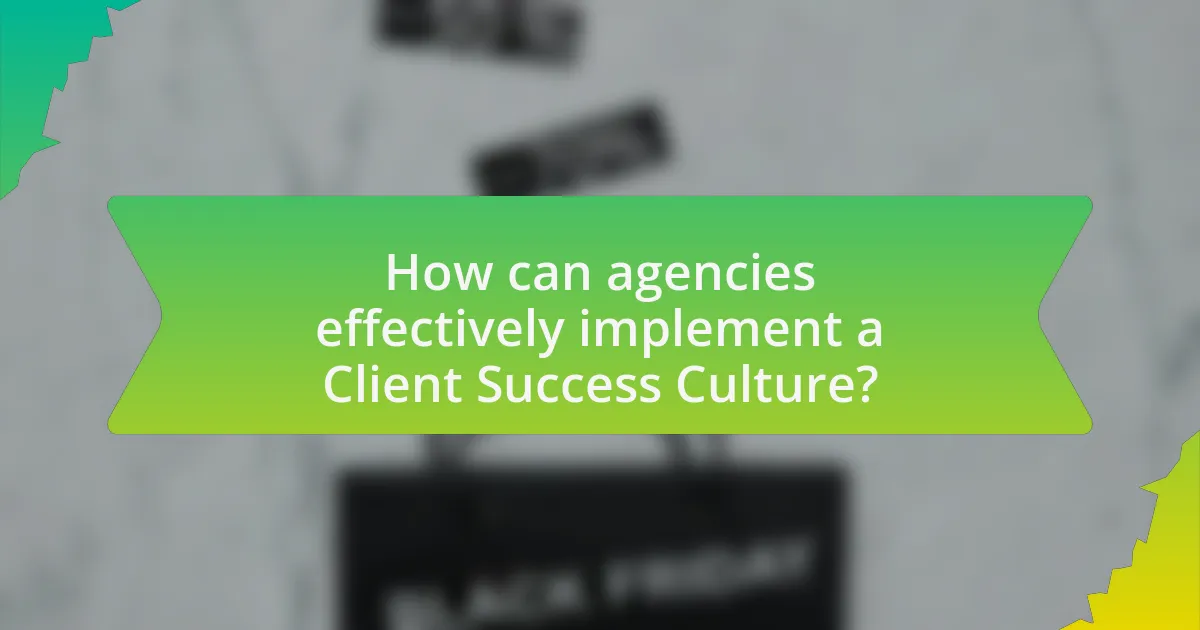A Client Success Culture within an agency is a systematic approach that prioritizes client satisfaction and success throughout their engagement. This culture emphasizes proactive communication, understanding client needs, and delivering tailored solutions, leading to improved client retention and increased referrals. Key characteristics include a customer-centric mindset, measurable outcomes, and cross-functional collaboration, all supported by strong leadership and clear values. The article explores the foundational elements necessary for implementing this culture, strategies for fostering it, and the tools and metrics that can enhance client success initiatives, while also addressing common challenges agencies may face in this transformation.

What is a Client Success Culture within an Agency?
A Client Success Culture within an agency is a systematic approach that prioritizes the satisfaction and success of clients throughout their engagement with the agency. This culture emphasizes proactive communication, understanding client needs, and delivering tailored solutions to ensure clients achieve their desired outcomes. Agencies that adopt a Client Success Culture often see improved client retention rates and increased referrals, as satisfied clients are more likely to advocate for the agency. Research indicates that organizations with a strong client success focus can experience up to 25% higher customer retention, demonstrating the tangible benefits of such a culture.
How does a Client Success Culture differ from traditional agency cultures?
A Client Success Culture prioritizes the long-term satisfaction and success of clients, contrasting with traditional agency cultures that often focus on project completion and immediate deliverables. In a Client Success Culture, agencies actively engage with clients to understand their goals and challenges, fostering ongoing relationships and support, whereas traditional cultures may emphasize transactional interactions and short-term outcomes. This shift is supported by research indicating that companies with a strong client success focus experience higher client retention rates and increased revenue, demonstrating the effectiveness of prioritizing client relationships over mere project execution.
What are the key characteristics of a Client Success Culture?
A Client Success Culture is characterized by a proactive approach to client engagement, a commitment to understanding client needs, and a focus on delivering measurable outcomes. This culture emphasizes collaboration across teams to ensure that client feedback is integrated into service delivery, fostering long-term relationships. Additionally, it prioritizes continuous improvement through data-driven insights, enabling agencies to adapt and enhance their offerings based on client experiences. Research indicates that organizations with a strong client success culture see higher client retention rates and increased revenue, demonstrating the tangible benefits of such an approach.
Why is a Client Success Culture essential for agency growth?
A Client Success Culture is essential for agency growth because it directly enhances client retention and satisfaction, leading to increased revenue. Agencies that prioritize client success foster stronger relationships, which can result in higher client loyalty and repeat business. According to a study by Bain & Company, increasing customer retention rates by just 5% can increase profits by 25% to 95%. This demonstrates that a focus on client success not only improves client experiences but also significantly impacts the financial health of the agency.
What are the foundational elements of a Client Success Culture?
The foundational elements of a Client Success Culture include a customer-centric mindset, proactive communication, measurable outcomes, and cross-functional collaboration. A customer-centric mindset prioritizes the needs and goals of clients, ensuring that their success is the primary focus of the organization. Proactive communication involves regularly engaging with clients to understand their challenges and provide timely solutions, which fosters trust and strengthens relationships. Measurable outcomes are essential for tracking client success, as they allow organizations to assess the effectiveness of their strategies and make data-driven decisions. Cross-functional collaboration ensures that all departments work together to support client success, creating a unified approach to service delivery. These elements collectively contribute to a culture that values and promotes client success as a core organizational principle.
How do values and mission statements influence Client Success?
Values and mission statements significantly influence Client Success by establishing a clear framework for decision-making and behavior within an organization. When an agency articulates its core values and mission, it aligns its team around a shared purpose, fostering a culture that prioritizes client needs and satisfaction. This alignment enhances communication and collaboration, leading to more effective problem-solving and service delivery. Research indicates that organizations with strong mission statements experience higher employee engagement, which correlates with improved client relationships and retention rates. For instance, a study by the Harvard Business Review found that companies with clearly defined values outperform their competitors in client satisfaction metrics. Thus, values and mission statements serve as foundational elements that drive Client Success through enhanced organizational coherence and commitment to client-centric practices.
What role does leadership play in establishing this culture?
Leadership plays a crucial role in establishing a client success culture within an agency by setting the vision and values that prioritize client satisfaction. Effective leaders model behaviors that emphasize the importance of client relationships, fostering an environment where team members are encouraged to prioritize client needs. Research indicates that organizations with strong leadership commitment to client success experience higher client retention rates and satisfaction scores, as leaders actively promote a culture of accountability and responsiveness. For instance, a study by the Harvard Business Review found that companies with engaged leadership teams are 50% more likely to have high customer satisfaction levels, demonstrating the direct impact of leadership on cultivating a client-centric culture.

How can agencies effectively implement a Client Success Culture?
Agencies can effectively implement a Client Success Culture by prioritizing client outcomes and aligning their internal processes to support these goals. This involves establishing clear communication channels, training staff on client engagement strategies, and utilizing data analytics to measure client satisfaction and success metrics. For instance, organizations that adopt a proactive approach to client feedback, such as regular check-ins and surveys, can identify areas for improvement and enhance client relationships. Research indicates that companies with strong client success initiatives experience a 20% increase in client retention rates, demonstrating the tangible benefits of such a culture.
What strategies can agencies adopt to foster a Client Success Culture?
Agencies can foster a Client Success Culture by implementing proactive communication, personalized service, and continuous feedback mechanisms. Proactive communication ensures that clients are regularly updated on project progress and potential challenges, which builds trust and transparency. Personalized service involves tailoring solutions to meet individual client needs, enhancing satisfaction and loyalty. Continuous feedback mechanisms, such as surveys and regular check-ins, allow agencies to gauge client satisfaction and make necessary adjustments, thereby reinforcing a commitment to client success. These strategies collectively create an environment where client needs are prioritized, leading to improved retention and long-term partnerships.
How can employee training and development support this culture?
Employee training and development can significantly support a client success culture by equipping employees with the necessary skills and knowledge to effectively meet client needs. This training fosters a deep understanding of client expectations and enhances communication skills, which are crucial for building strong client relationships. For instance, organizations that invest in training programs report a 24% increase in employee engagement, leading to improved client satisfaction and retention rates. Furthermore, continuous development initiatives encourage a proactive approach to problem-solving, enabling employees to anticipate client challenges and deliver tailored solutions. This alignment between employee capabilities and client success objectives ultimately strengthens the overall culture within the agency.
What tools and technologies can enhance Client Success initiatives?
Tools and technologies that can enhance Client Success initiatives include Customer Relationship Management (CRM) systems, customer feedback platforms, and data analytics tools. CRM systems, such as Salesforce or HubSpot, enable agencies to manage client interactions and track engagement effectively, leading to improved client relationships. Customer feedback platforms like SurveyMonkey or Qualtrics facilitate the collection of client insights, allowing agencies to adapt their services based on client needs. Data analytics tools, such as Google Analytics or Tableau, provide actionable insights into client behavior and preferences, enabling agencies to tailor their strategies for better client outcomes. These tools collectively support a proactive approach to Client Success, ensuring that agencies can respond to client needs promptly and effectively.
How can agencies measure the success of their Client Success Culture?
Agencies can measure the success of their Client Success Culture through key performance indicators (KPIs) such as client retention rates, Net Promoter Score (NPS), and customer satisfaction surveys. These metrics provide quantifiable data reflecting client loyalty and satisfaction, which are essential components of a successful Client Success Culture. For instance, a high NPS indicates that clients are likely to recommend the agency, demonstrating effective client engagement and satisfaction. Additionally, tracking client retention rates over time can reveal the agency’s ability to maintain long-term relationships, which is a direct indicator of a thriving Client Success Culture.
What metrics should agencies track to evaluate Client Success?
Agencies should track metrics such as Net Promoter Score (NPS), Customer Satisfaction Score (CSAT), Customer Lifetime Value (CLV), and churn rate to evaluate client success. NPS measures client loyalty and likelihood to recommend services, while CSAT assesses overall satisfaction with specific interactions. CLV quantifies the total revenue expected from a client over the duration of the relationship, providing insight into long-term value. Churn rate indicates the percentage of clients lost over a specific period, highlighting retention effectiveness. These metrics collectively offer a comprehensive view of client success and agency performance.
How can client feedback be utilized to improve the culture?
Client feedback can be utilized to improve the culture by actively integrating insights from clients into the agency’s operational practices and values. This integration fosters a culture of responsiveness and adaptability, as employees become more aware of client needs and expectations. For instance, agencies that regularly collect and analyze client feedback can identify areas for improvement, leading to enhanced service delivery and employee engagement. Research indicates that organizations that prioritize client feedback experience a 10-15% increase in customer satisfaction, which correlates with a more positive internal culture. By creating feedback loops, agencies can ensure that client perspectives shape decision-making processes, ultimately cultivating a culture that values collaboration and continuous improvement.

What challenges might agencies face in cultivating a Client Success Culture?
Agencies may face several challenges in cultivating a Client Success Culture, including resistance to change, lack of alignment among teams, and insufficient training. Resistance to change often arises when employees are accustomed to traditional methods and may be hesitant to adopt new practices focused on client success. Lack of alignment among teams can lead to inconsistent messaging and efforts, undermining the overall goal of enhancing client satisfaction. Insufficient training can hinder employees’ ability to effectively engage with clients and understand their needs, which is crucial for fostering a culture centered on client success. These challenges can impede the establishment of a cohesive and effective Client Success Culture within agencies.
What common obstacles hinder the development of a Client Success Culture?
Common obstacles that hinder the development of a Client Success Culture include lack of alignment between departments, insufficient training for staff, and inadequate measurement of client success metrics. Lack of alignment can lead to fragmented communication and inconsistent client experiences, as different teams may prioritize their own goals over client needs. Insufficient training prevents employees from effectively engaging with clients and understanding their needs, which is crucial for fostering a client-centric approach. Additionally, without proper measurement of client success metrics, organizations struggle to identify areas for improvement and may fail to recognize the impact of their efforts on client satisfaction and retention.
How can agencies overcome resistance to change within their teams?
Agencies can overcome resistance to change within their teams by fostering open communication and involving team members in the change process. Engaging employees in discussions about the reasons for change and soliciting their input can reduce anxiety and build trust. Research shows that organizations that prioritize employee involvement during transitions experience a 70% success rate in implementing change initiatives, as highlighted in a study by Kotter International. This approach not only addresses concerns but also empowers team members, making them more likely to embrace new strategies that align with a client success culture.
What strategies can be employed to maintain momentum in Client Success initiatives?
To maintain momentum in Client Success initiatives, agencies should implement regular check-ins and feedback loops with clients. These strategies ensure ongoing communication, allowing for the identification of issues and opportunities for improvement. Research indicates that organizations with structured feedback mechanisms experience a 20% increase in client satisfaction and retention rates. By actively engaging clients through surveys and meetings, agencies can adapt their services to meet evolving client needs, thereby sustaining momentum in Client Success initiatives.
What best practices can agencies follow to sustain a Client Success Culture?
Agencies can sustain a Client Success Culture by prioritizing proactive communication, fostering strong relationships, and implementing continuous feedback mechanisms. Proactive communication ensures that clients are regularly updated on progress and challenges, which builds trust and transparency. Strong relationships are cultivated through personalized interactions and understanding client needs, leading to increased satisfaction and loyalty. Continuous feedback mechanisms, such as surveys and regular check-ins, allow agencies to adapt their services based on client input, ensuring that they meet evolving expectations. These practices are supported by research indicating that organizations with strong client engagement strategies see a 10-20% increase in client retention rates, highlighting the effectiveness of a Client Success Culture.
How can continuous improvement be integrated into Client Success efforts?
Continuous improvement can be integrated into Client Success efforts by implementing regular feedback loops and performance metrics. Establishing a system for collecting client feedback through surveys or direct communication allows agencies to identify areas for enhancement. Additionally, utilizing key performance indicators (KPIs) such as customer satisfaction scores and retention rates provides measurable data to assess the effectiveness of Client Success initiatives. Research shows that organizations that actively seek and act on client feedback can increase customer retention by up to 5%, highlighting the importance of continuous improvement in fostering long-term client relationships.
What role does communication play in sustaining this culture?
Communication is essential in sustaining a client success culture within an agency as it fosters transparency, collaboration, and alignment among team members. Effective communication ensures that all employees understand client needs, expectations, and the agency’s goals, which enhances service delivery. For instance, regular feedback loops and open dialogue facilitate the sharing of insights and best practices, leading to improved client relationships and satisfaction. Research indicates that organizations with strong communication practices experience 47% higher employee engagement, which directly correlates with better client outcomes. Thus, communication not only supports the internal culture but also drives external client success.
What practical steps can agencies take to enhance their Client Success Culture?
Agencies can enhance their Client Success Culture by implementing regular training programs focused on client relationship management. These programs equip employees with the skills necessary to understand client needs and foster strong relationships. Research indicates that organizations with comprehensive training programs see a 24% increase in customer satisfaction scores, demonstrating the effectiveness of such initiatives. Additionally, agencies should establish clear communication channels for client feedback, allowing for continuous improvement based on client insights. This approach not only builds trust but also aligns agency services with client expectations, further solidifying a culture centered on client success.


